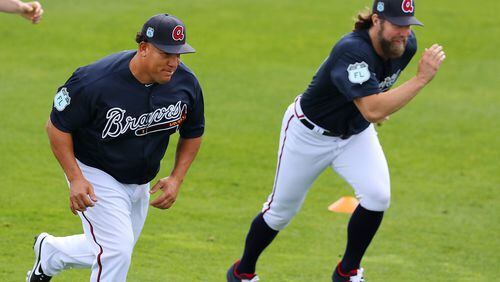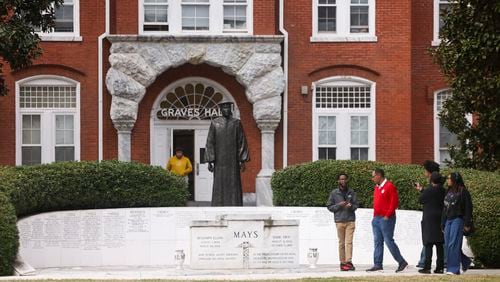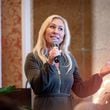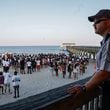When Braves hitting coach Kevin Seitzer first got a load of Bartolo Colon, he was more a semi-Colon, a scaled-down version of his current robust self.
Nearly 100 pounds lighter and 20 years younger, Colon began his major league odyssey — emphasis on the odd — in April, 1997, starting for the Cleveland Indians. So stubbornly enduring has Colon been that his first baseman that day is now a 53-year-old batting sensei for the team that is still paying him to pitch.
“He came up throwing absolute gas, 97-98-99 (mph). Movement. Great breaking ball. But not really any idea where it was going,” Seitzer remembered.
“He was a special talent, you could tell. To see him transition into the type of pitcher he has become — being a command guy with really great movement, ability to add and subtract (velocity), just how easy he plays the game — it has been really fun to watch his career.”
Yes, fun is one word for it.
Before Colon has thrown his first pitch for the Braves, his ninth team in 20 years, the team already has a bobblehead day planned for him at the new stadium this summer. Some wise guy suggested a bobblebody might be a more apt souvenir for the player listed at 5-11, 285 pounds.
Before he has taken his first awkward slash at the plate for his new team — helmet flying one way, body lunging another like a pygmy hippo on roller skates — a curious world wants to know if he has one more home run in him. It was last season that the lifetime .091 hitter (with the .116 slugging percentage) connected for his one and only homer, an event that gave all of baseball a bad case of the giggles and earned Colon a Guinness World Records certificate as the oldest human on record hitting his first major league home run.
“I don’t want to put any doubt in my head, so who knows?” Colon said earlier this week. “I want to keep taking at-bats, and if I can hit one more, great.” Despite coming to the U.S. from the Dominican Republic first in 1994, Colon still conducts his interviews, infrequent we are told, with the aid of an interpreter.
“Big Sexy,” the planet has taken to calling him, with a wry smile. And what does the man himself think of that sarcastic handle? “Not much really,” he said. “Just one of those nicknames that (Mets teammate Noah) Syndergaard gave me. Syndergaard was a great teammate and friend of mine.”
Now, it was not for comic relief that the Braves signed the oldest player in baseball to a one-year deal in November for $12.5 million, not some Bill Veeck carnival bark. They went on the market and picked up a Costco value pack of second-hand arms in Colon, R.A. Dickey and Jamie Garcia to fill out their starting rotation while waiting on all the prospects to ripen.
In Colon they acquired a resilient sort who has averaged just more than 15 wins and 194 innings pitched per season since turning 40. He will turn 44 by the time this season is a month old and still will have not met his self-determined professional expiration date. “I always used to tell my mother, God rest her soul, that I always wanted to play until I was 45 years old,” he said.
The Braves got themselves a pitcher who still relies upon his fastball. It was, according to Fangraphs, nearly 90 percent of his repertoire last year. Only his fastball isn’t as fast as it used to be. His average speed of the pitch was 88 mph last year, which is plenty if you can pinpoint it and tip the hitter off balance with subtle changes of speed. And pound the strike zone. Why, in one game with Oakland in 2012, Colon threw 38 consecutive strikes.
Pay attention, all you youngsters on the Braves’ staff. You might learn something.
“What’s most impressive is how much we have to change over the years in order to stay competitive at this level,” said Dickey, who made himself over into a knuckleballer in order to save his career. “To see (Colon) do that in a bunch of different ways, just to see his metamorphosis to what he is now to what he was then is very impressive.”
His longevity is Colon’s most compelling response to the notion that his Fred Flintstone body is the product of simple neglect, that he has completely ignored the vessel of his career. Results, not aesthetics, are what matter here. “He obviously knows how to get in shape to log all the innings in the years that he has,” Braves manager Brian Snitker said. “(Colon’s conditioning) is the last thing I’m going to worry about.”
“He had a good body, he was a strong dude,” Seitzer recalled of the ’97 Colon model. “He’s still strong, he just carries it a little bit different now. He’s not soft like a lot of people think.”
Early in the Braves spring, Colon was on the back fields going through all the drills requiring some agility — covering first, fielding bunts — without need of a scooter. He already established himself the star of long toss with some throws that required practically no arc to defeat gravity.
In Colon’s beginnings were all the ingredients for cult-figure status. In his hillside village in the Dominican, Colon reportedly developed his arm strength while turning the crank on a contraption that stripped the pulp from coffee beans. And his accuracy was honed by throwing rocks at fruit to knock sustenance from the tree. “Throwing at coconuts and mangoes, but the coconut was the most difficult,” he once told the New York Times.
Like his baseball career, Colon’s image has been resilient. He has remained a highly popular figure despite incidents that might doom a fellow of lesser dimensions.
Chief among those was his 50-game suspension for steroids use in 2012. Two years before, Major League Baseball had looked into a stem-cell procedure credited with rejuvenating his shoulder, but found nothing to act upon. When Boston tried to send him to the bullpen in 2008, Colon went home rather than accept the assignment.
While with the Mets last year, he made an appearance in the New York tabloids as a defendant in a child-support lawsuit.
Whether because he remains something of an enigma to the American audience or because he defies every preconception about what an athlete should look like, Colon still commands this wealth of mostly positive public curiosity.
Hey, he can also pitch, as his 2005 Cy Young Award and four All-Star designations attest (he was on the 2016 team, but did not appear in the game).
With the Braves, he’ll chase some records that are especially significant to a large part of the baseball-playing world. Colon (233-162 career) needs 10 wins to surpass Juan Marichal’s major league record for most victories by a pitcher from the Dominican Republic, and 13 to pass Dennis Martinez for most major league wins by a Latin American player.
“It’s real important to me, but I think my primary focus is to stay healthy. If I can stay healthy, we’ll see where it goes from there,” Colon said.
Surpassing those marks certainly would make Colon more than an amusement, more than a bridge until someone younger comes along. It might even make him an actual foundation to a season. Wouldn’t that be fun?
About the Author







